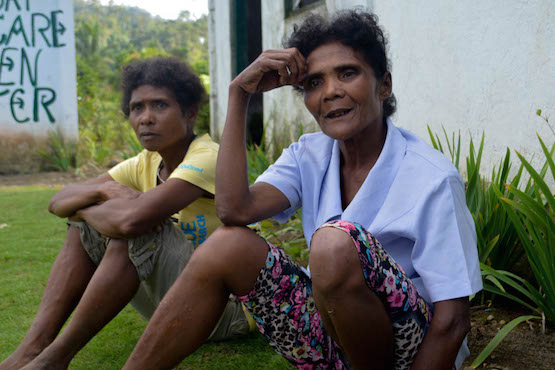Food, shelter, medical care proves scarce for highlands indigenous community
 |
| Mamanwa women in the village of Kagbana in Leyte province express gratitude for help given by church groups. (Photo by Ronald Reyes) |
Ronald Reyes, Tacloban City, Philippines
March 1, 2016
Deep in the mountains of Kagbana in the town of Burauen in Leyte province, Bernal Banagbanag, the 90-year-old chieftain of the Mamanwa tribe, weaves the last strand of a rattan basket he has been laboring on for days.
"This basket can be my last," Bernal says. "Nobody has been buying our baskets now," adds the tribal chief, pointing at his handiwork, which he says helped him and his family survive through the years.
Junie, the 46-year-old son of Bernal, says typhoon Haiyan, which devastated the province of Leyte in 2013, destroyed all their coconut and abaca plants.
"We can only make baskets for a living now," says Junie. The problem, however, is nobody has been buying their basket. "We have no money for rice and to send our children to school," he adds.
"We need help," says Bernal. "We can finish one basket in a day or two. We can make many if there will be orders," he says.
The baskets are sold between US$2 to US$8 each, depending on the size.
The trade and industry department in Easter Visayas region can only offer Bernal and Junie a place to sell their products.
Marcelita Lozada, a 53-year-old mother of seven children, says her far-flung village also needs medical attention.
"We only see a doctor about once a year," she says. When doctors do come, they hand out a handful of pills, mostly pain relievers," Marcelita adds.
"I have problem with my eyes. I hope someone will help me," she says.
It takes about six hours through rivers and hills to reach the Mamanwa village.
"Our situation is very difficult. We can only eat rice twice or thrice a month," said Marcelita. "What we eat are root crops," she says.
 |
| Bernal Banagbanag, Mamanwa chieftan, teaches children how to weave baskets in the hinterland village of Kagbana. (Photo by Ronald Reyes)
Typhoon brings blessings
It was only when typhoon Haiyan hit the village in 2013 that lowlanders became aware of the Mamanwa tribe of Leyte.
"We are thankful for the typhoon," says Junie. "People started to notice us," he says.
Relief workers brought them new clothes, sandals, and food.
Church groups, especially Catholic Relief Services came and helped the tribe rebuild their homes.
Father James Meneses of the Commission of Indigenous Peoples of Palo Archdiocese says the Mamanwas are already included in programs that are part of the church's recovery efforts in devastated areas.
"We give them the same form of assistance from relief, livelihood, and shelter support," says Father Chris Arthur Militante from the same archdiocese.
"In fact they are the target of our apostolate and mission work," he adds.
Marcelita, however, says they only hear Mass once a year, during the feast of their village's patron saint.
"As I grow older I feel more desperate," she says.
A total of 1.8 million people affected by typhoon Haiyan has been served by the Catholic Church and its various organizations since 2013.
"We choose the poorest of the poor," says Father Edwin Gariguez, executive secretary of Caritas in the Philippines. "This is what we call service," he adds.
The priest says Caritas has already spent about US$67 million for Haiyan victims.
"We make sure that transparent and honest spending is being practiced in all levels," says Gariguez, adding that beneficiaries of church aid is 20 percent of the total population affected byHaiyan.
"But it should not stop there," says the priest. "We must go beyond mere relief and push through early recovery and eventual rehabilitation. This is the more humane way of helping," he adds.
Junie is thankful that people from the lowland have noticed the tribe.
"Our huts were made of grass before, but now our roofs are already made of galvanized iron," he says with a smile.
First published in Union of Catholic Asian News (UCA News), March 1, 2016
|